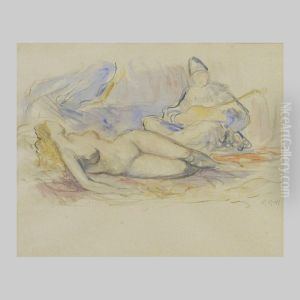Giuseppe Croff Paintings
Giuseppe Croff was an Italian sculptor born on November 15, 1808, in Milan, Italy. His artistic career blossomed during the 19th century, which was a period marked by Romanticism in the arts, a movement that originated in Europe towards the end of the 18th century. This movement emphasized intense emotion as an authentic source of aesthetic experience, and it was against the order and rationality that characterized Neoclassicism, which preceded it. Croff's works, however, often reflected a blend of these styles, combining classical forms with romantic themes and sentiments.
Croff trained at the Brera Academy in Milan, which was one of the most prestigious art schools in Italy at the time. There, he was able to learn from some of the most prominent artists and teachers of his era. Throughout his career, he was known for his skillful craftsmanship in marble, which was the preferred medium for many sculptors of his time due to its association with the revered traditions of ancient Greek and Roman art.
One of Croff's most famous works is 'The Veiled Nun', a marble bust that showcases his ability to create the illusion of transparent veils from the solid stone, a technique that was highly appreciated in his time and is still admired today for its technical difficulty and aesthetic delicacy. The sculpture is an excellent example of the way Italian sculptors like Croff were able to infuse their classical training with the emotive and imaginative characteristics of Romantic art.
Giuseppe Croff's contributions to sculpture were part of a larger Italian tradition that maintained a strong presence in European art throughout the 19th century. His works were exhibited and appreciated in his home country as well as internationally, and they reflect the historical and cultural transitions of his time. Croff passed away on August 18, 1885, in Milan, leaving behind a legacy that continues to be studied and admired by art historians and enthusiasts.
